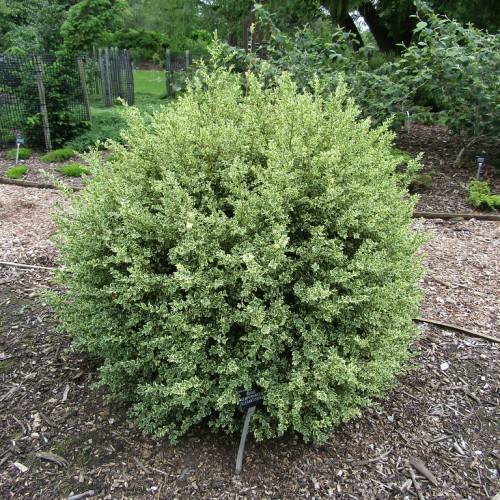
boxwood
Buxus sempervirens 'Elegantissima'
Cycle:
Perennial
Watering:
Average
Hardiness Zone:
5 - 8
Flowers:
Flowers In Spring
Sun:
Deep shade, Filtered shade, Full sun only if soil kept moist, Part sun/part shade
Soil:
Alkaline, Well-drained
Fruits:
Fruits In Summer Ready In Fall
Leaf:
Yes
Growth Rate:
Moderate
Maintenance:
Moderate
Care Level:
Medium
watering
Boxwood (Buxus sempervirens 'Elegantissima') should be watered about once a week, as it is a slow-growing, drought-tolerant plant. It is important to provide deep and thorough watering that completely saturates the soil and encourages deep root growth. When watering, use a hose or watering can and water slowly and deeply until water is seen draining out of the bottom of the pot. It may be necessary to water more often during hot, dry weather. In winter months, the plant can go without watering for longer periods of time, as it is not actively growing during these months.
sunlight
Boxwood (Buxus sempervirens 'Elegantissima') does best when situated in a location that receives full sunlight during most of the day. Ideally, boxwood should receive at least 4 to 6 hours of direct sunlight each day during the summer season. During the winter season, however, it is best to reduce the amount of direct sunlight that the plant receives to 2 to 4 hours each day. The sunlight should also be diffused, meaning that it should not be overly harsh and direct. It is also important to note that while boxwood can tolerate some shade, it does best when it receives the full sunlight that it needs.
pruning
Boxwood (Buxus sempervirens 'Elegantissima') requires pruning once a year in late winter to shape and maintain its form. The pruning should be made just before the new growth begins, so usually late February or early March is most suitable. Pruning boxwood should be done to keep its density and size in check, and to clean out any dead branches. Typically, pruning should remove 10-15% of the plant to avoid damaging the plant and remove up to a third of the leaf tips in order to raise the desired shape. If any branches need to be removed, make sure any pruning cuts are made cleanly and close to the trunk. The tips of any new shoots should also be pruned to encourage a bushy, full growth.
Season
Hardiness Map
FAQ
Is Boxwood a popular landscape plant?
Yes, Boxwood is a popular landscape plant, due to its versatility in design, hardiness in cold temperatures, attractive foliage and its ability to be pruned into a variety of shapes. It makes an attractive year-round hedge, foundation plant or edging and, if left unpruned, can be grown as a small tree or shrub. Boxwoods can be planted either in the sun or partial shade and are a great addition to gardens of any size.
Are Boxwoods evergreen?
Yes, boxwoods are evergreen. They have deep green foliage and remain an attractive evergreen tree year-round, allowing for a versatile way to add color and structure to outdoor spaces. Boxwoods are also extremely easy to grow, making them a great choice for novice gardeners. Additionally, boxwoods are relatively low maintenance and can handle some light pruning if needed.
Can Boxwoods be trimmed into shapes?
Yes, boxwoods can be trimmed into shapes. With regular maintenance and occasional pruning, they can be cut and shaped into hedges, topiary, round forms and other creative patterns. Pruning them regularly also ensures that they remain healthy and look their best. It is important to trim them with the right tools and techniques in order to keep them healthy, while also achieving the desired shape.
Could Boxwoods be used as a hedge plant?
Yes, boxwoods can be used as a hedge plant. They are low-maintenance, evergreen shrubs that can be trimmed to create uniform hedges or shaped into topiary. Boxwoods are also resistant to disease and can tolerate both full sun and partial shade. They are ideal for small to medium hedges and make an attractive backdrop for annual and perennial flowers.
Should Boxwoods be planted in full sun or shade?
It depends on the variety of boxwood you have. Some varieties, such as English boxwood, are best planted in full sun for optimal growth and form. However, other varieties such as American and Korean boxwood do better in partial shade due to the more intense heat of full sun. In areas with long, hot summers and mild winters, provide some shade protection to prevent over-heating and drying out, especially during the hottest times of day.
